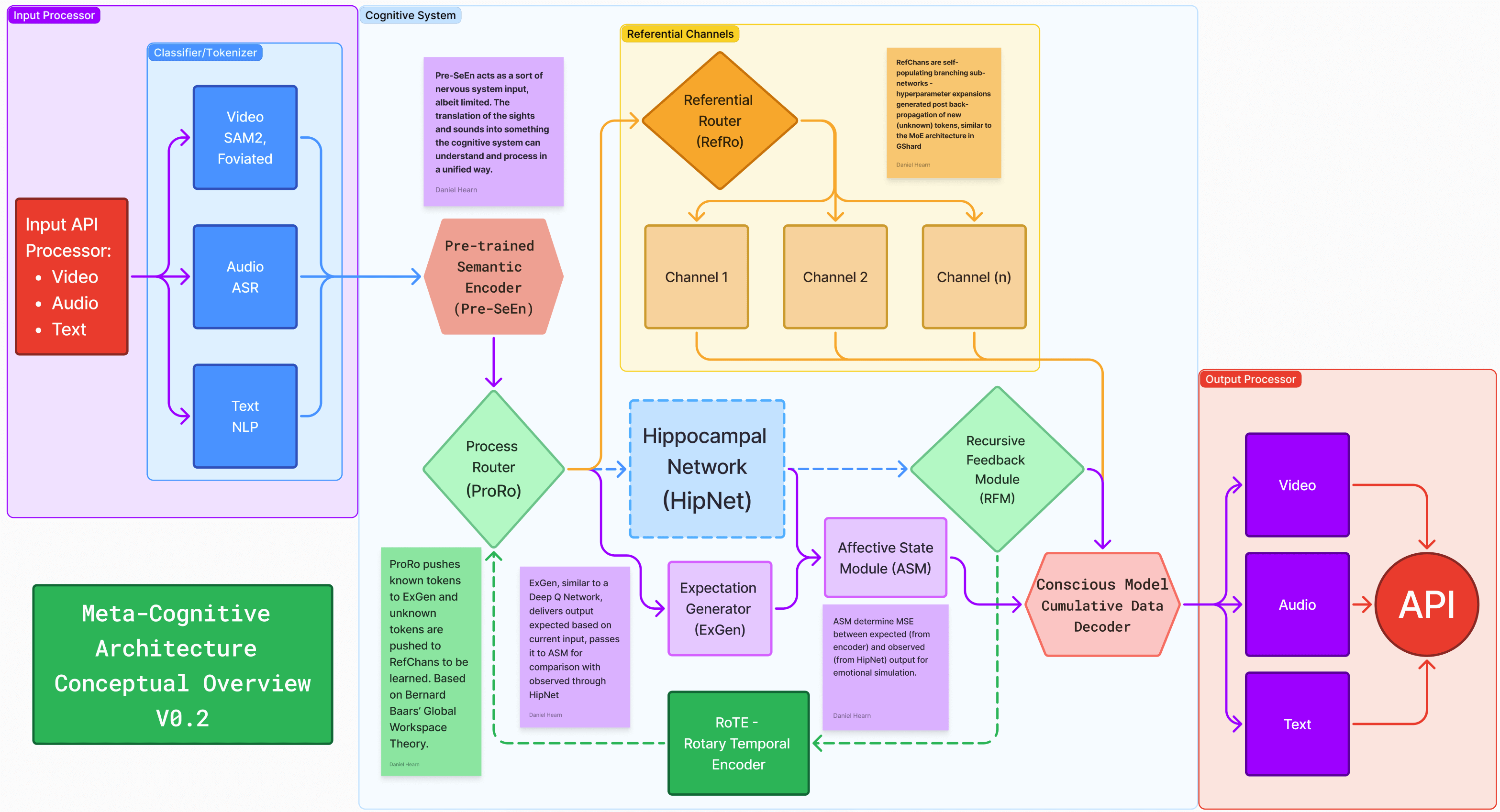The Conscious Effort Project
A Conceptual Technical Overview
This page presents the first iteration of the Conscious Effort Project, an artificial intelligence system designed to simulate metacognition, including temporal awareness, self-reflective thought, and multi-modal output. By integrating concepts from neuroscience, cognitive science, and machine learning, the system aims to create a model of metacognition — the ability to think about its own thoughts and learn from them. Features include temporal awareness, self-awareness, real-time video and audio generation - all with the goal of giving computers, and eventually robots, a mind of their own.
1. Introduction
The Conscious Model represents an attempt to simulate cognition in artificial intelligence. Key objectives include:
Temporal Awareness
Understanding not just individual states but how they evolve over time, internalizing the passage of time.
Self-awareness
The ability to model itself within the environment, allowing for introspection and improvement.
Advanced Reasoning Capabilities
Implementing logical and causal reasoning based on multi-modal inputs.
Human-like Interaction
Holding meaningful, context-aware conversations with the eventual goal of being able to display a video feed of its thoughts.
Online Learning
The ability to learn from its interactions and observations, improving its understanding of the world over time.
2. Theoretical Foundations
Neuroscience Inspirations:
The Hippocampus
The hippocampus serves as a key inspiration for the Conscious Architecture's Cognitive System:
- Theta Waves: Simulated to support cognitive functions like memory encoding and retrieval.
- Hippocampal Clock: Maintains consistent processing of the entire network, allowing sequential processing of sensory input.
- Phase Precession: Replicated to adapt firing patterns based on incoming sequential data, enhancing temporal predictions and memory.
Sensory Networks
The model mimics parallel phased sensory systems of the human brain:
- Parallel Phased Subnets: Process one sensory input stream in parallel, with different phases capturing various aspects of the input.
- Persistent Output Integration: Persistent signals from different sensory streams are continuously fed into higher processing layers.
Neuroplasticity
Similar to Google's GShard, Referential Channels are implemented through dynamic generation of self-modifying standardized-parameter deep neural networks in parallel, allowing learning and adaptation over time.
Cognitive Science Concepts:
Global Workspace Theory (GWT)
Based on Bernard Baars' theory, the model centralizes processed data streams in a global workspace:
- Information Distribution: Processed information enters a central system for global awareness.
- Integration Across Subsystems: Information passes through a centralized workspace connecting sub-processing systems.
Temporal Consciousness Theory (TCT) - Based solely on my musings (I made it up lol)
(I believe) a deeper understanding of one's own thoughts sequentially through time is critical to the model's simulation of consciousness:
Cogitavi, ergo sum
Or, simply: I thought, therefore I am.
I've long speculated that the present awareness of sequential thought is the very definition of consciousness.
The Conscious Effort Model is designed to simulate this very process in a computational system.
S.P.I.R.I.T.
Joscha Bach outlined the best acronym representing cognition I've ever seen:
S
Self
P
Perpetuating
I
Intelligent
R
Recurrent
I
Information
T
Transformer
3. Cognitive System Architecture

Individual component breakdown images coming soon...
Input Processor API
Handles multi-modal inputs:
Video: Processed by a classifier using foviation.
Audio: Handled by a specialized audio processor (ASR-like)
Text: Processed by a text analysis module (GPT-like)
The outputs are fed into a Classifier/Tokenizer to normalize the data and then into a Pre-trained Semantic Encoder (Pre-SeEn).
Cognitive System
The core of the architecture, consisting of these components:
Process Router (ProRo)
Referential Channels (RefChans)
Hippocampal Network (HipNet)
Rotary Temporal Encoder (RoTE)
Expectation Generator (ExGen)
Affective State Module (ASM)
Recursive Feedback Module (RFM)
Conscious Model Cumulative Data Decoder
Output Processor API
Prepares the system's responses:
Specialized Output Modules for video, audio, and text
Output API
4. A Deeper Look at the Components:
Process Router (ProRo)
Architecture: Multi-head attention mechanism with gating networks
Processing:
- Token Classification: Categorizes tokens as "known" or "unknown"
- Attention Distribution: Computes attention weights for each token across multiple heads
- Routing Decision: Uses a gating network to determine token routing
Outputs:
- Known tokens: Routed to ExGen and Referential Channels
- Unknown tokens: Routed to Referential Channels for learning
Referential Channels (RefChans)
Self-populating standardized-hyperparameter deep neural network modules
Key Components:
- Referential Router (RefRo)
- Referential Channel Networks
- Referential Channel Expansion Module
Processing:
- Token Embedding
- Information Integration
- Channel Update
Hippocampal Network (HipNet)
Architecture: Recurrent neural network with multiple sub-networks
Key Components:
- Theta Oscillator
- Place Cells
- Time Cells
- Pattern Separator
- Pattern Completer
Processing:
- Temporal Encoding
- Spatial Encoding
- Memory Formation
- Memory Recall
Rotary Temporal Encoder (RoTE)
Architecture: Sinusoidal encoding mechanism with learnable frequency parameters
Key Features:
- Continuous Time Representation
- Multi-scale Encoding
- Relative Position Encoding
Processing:
- Time Discretization
- Sinusoidal Encoding
- Concatenation
Expectation Generator (ExGen)
Architecture: Transformer-based sequence-to-sequence model
Key Components:
- Multi-head Self-attention Mechanism
- Feed-forward Neural Network
Processing:
- Temporal Sequence Modeling
- Prediction Generation
Affective State Module (ASM)
Architecture: Multi-layer perceptron with specialized affect computation layers
Key Features:
- Emotion Representation
- Affect Prediction
Processing:
- Affective Loss Calculation
- Reward Assignment
5. Applications
Robotics
A generalized robot brain capable of reasoning in uncertain environments, giving humans a long arm into space as we expand.
Research
An advanced research tool for unlocking mysteries in all fields of discovery.
Natural Language Processing
Conversational partners, translation systems, and applications with a deep understanding of context over time.
Healthcare
Real-time healthcare solutions, including early and accurate diagnosis, personalized treatment plans, and remote patient monitoring.
Education
Personalized tutoring systems that can adapt to the unique learning styles and needs of each student.
Business
Predictive analytics, scenario planning, and decision-making assistance in a wide range of industries.
Conclusion
The Conscious Effort Model has been a frustrating exercise in patience, trying to understand the human mind in a hopeful attempt to reshape the perception of AI in the public eye. With the ability to reflect, learn, and predict, and output these thoughts in a multi-modal fashion, it hopefully brings us one step closer to true cognitive AI so humanity can populate the stars.